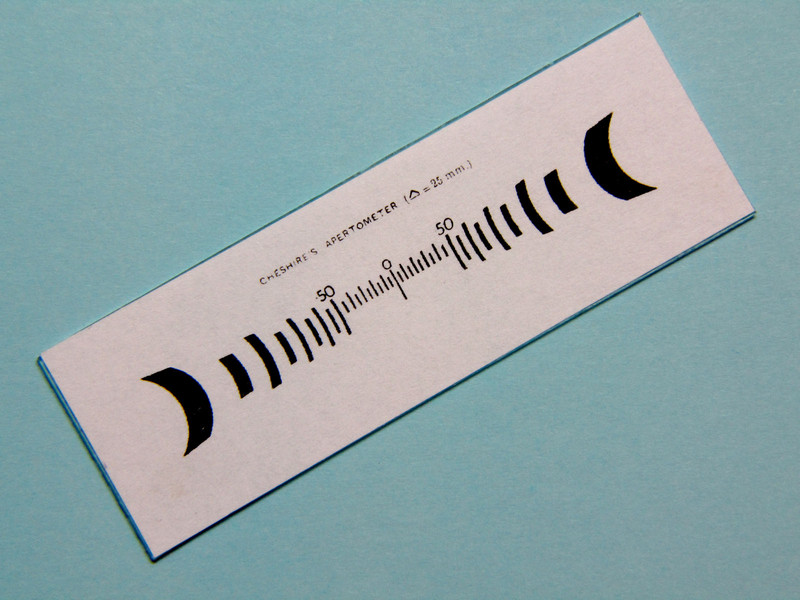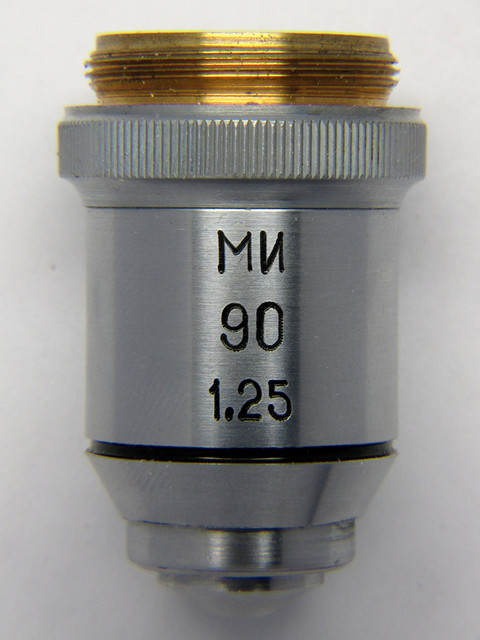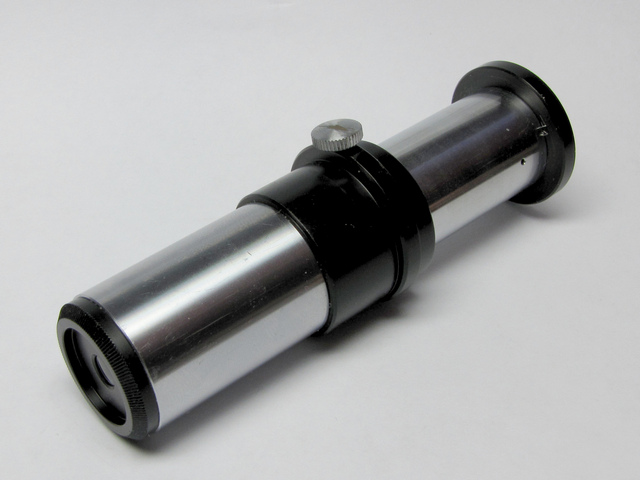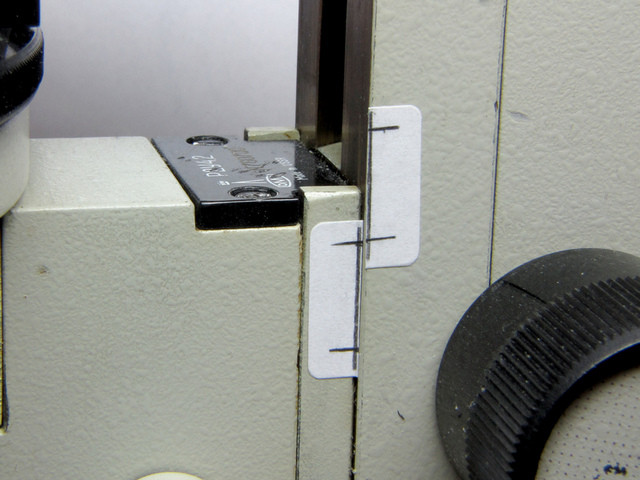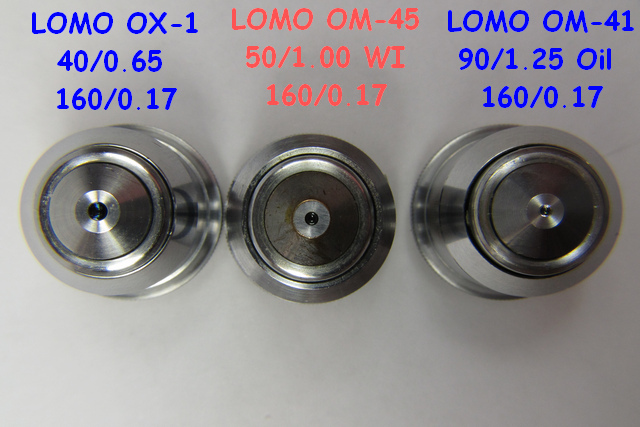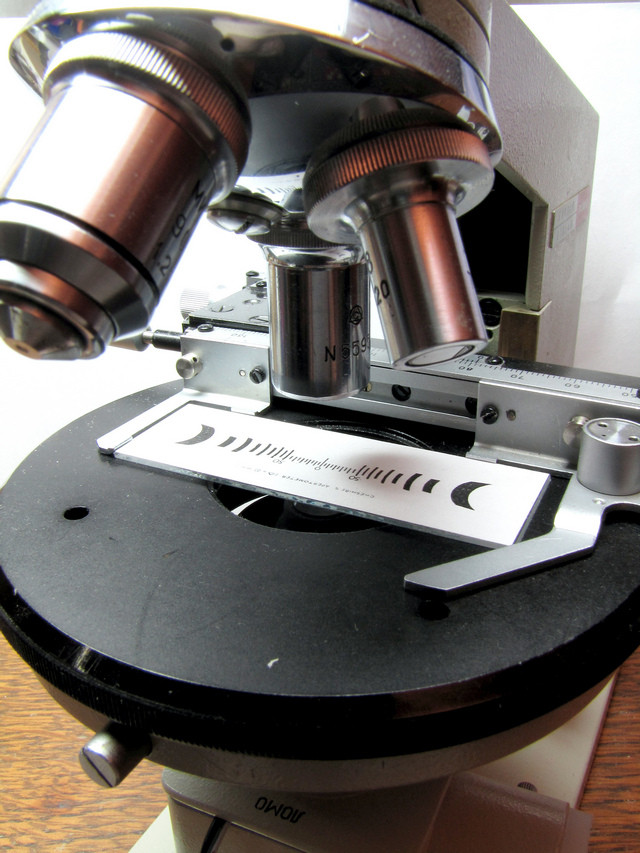| Measuring NA of the microscope objective | |||||||||||||||||||||||||||||||||||||||||||||||||||||||||||||||||||||||||||||||||
| using DIY Cheshire's Apertometer | |||||||||||||||||||||||||||||||||||||||||||||||||||||||||||||||||||||||||||||||||
| By Dushan Grujich, on February 2nd. 2013 | |||||||||||||||||||||||||||||||||||||||||||||||||||||||||||||||||||||||||||||||||
|
| |||||||||||||||||||||||||||||||||||||||||||||||||||||||||||||||||||||||||||||||||
|
I came by an immersion objective marked LOMO “МИ” i.e. OI 90/1.25 160/0.17. When I checked it, it became clear that objective does not correspond to what was engraved on its sleeve. Apparently someone has mistakenly screwed the wrong sleeve on to the objective, probably done when cleaning several objectives at the same time. | |||||||||||||||||||||||||||||||||||||||||||||||||||||||||||||||||||||||||||||||||
|
Usual markings on the objective, here giving false information | |||||||||||||||||||||||||||||||||||||||||||||||||||||||||||||||||||||||||||||||||
|
To try and identify
this objective, I measured the magnification which has shown it to be
50. This got me curious, as to the best of my knowledge LOMO did not
make achromatic objectives with magnification of 50. The next thing was to try and
determine the objective NA. A difficult task as I do not have access to any
sophisticated optical measuring equipment. | |||||||||||||||||||||||||||||||||||||||||||||||||||||||||||||||||||||||||||||||||
|
In a flash, I remembered Frederic J. Cheshire’s Apertometer1, which truly would be easy to make just by using an ordinary laser printer and ruler. | |||||||||||||||||||||||||||||||||||||||||||||||||||||||||||||||||||||||||||||||||
|
Thus, I went searching through a number of books and found references to Cheshire’s original article published in 1904 article1 and his later article2 describing the improvement to the apertometer, published in 1914, both in the "Journal of the Quekett Microscopical Club". | |||||||||||||||||||||||||||||||||||||||||||||||||||||||||||||||||||||||||||||||||
|
The theory behind Cheshire's design is explained in detail in his original 1904 article1, hence I shall deal here only with the practical application of the theory. | |||||||||||||||||||||||||||||||||||||||||||||||||||||||||||||||||||||||||||||||||
|
To describe it briefly. The apertometer consists of a number of concentric circles, drawn on paper, which are so spaced and graduated in thickness so that when the diagram which they form is placed on the stage of the microscope, at a certain distance, delta, below the usual object plane of the objective to be tested, the circles project into the upper focal plane of this objective as a number of equidistant, equithick concentric circles. Just from an observation of the number of circles visible, the N.A. is read off directly. | |||||||||||||||||||||||||||||||||||||||||||||||||||||||||||||||||||||||||||||||||
|
The first and smallest circle corresponds to an N.A. of O.l, the second to O.2, and so on up to N.A. 0.9. Intermediate values are estimated by the eye. The observation of the image of the diagram in the upper focal plane is made removing the eyepiece and fitting the top of the draw-tube with a phase contrast telescope. | |||||||||||||||||||||||||||||||||||||||||||||||||||||||||||||||||||||||||||||||||
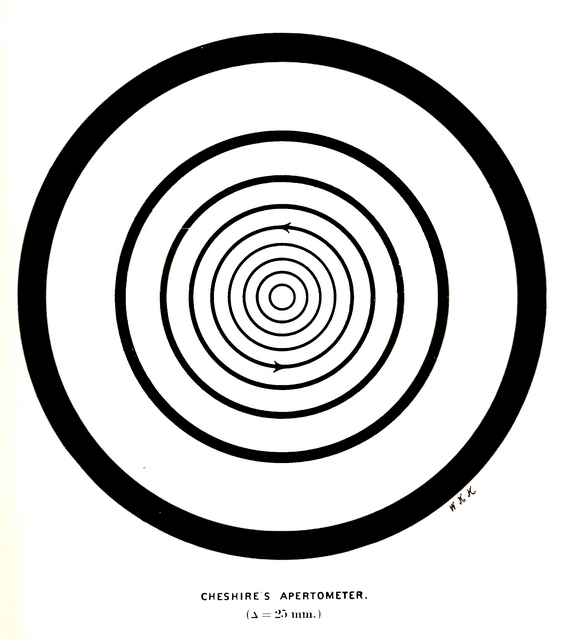
The original, 1904 design of Cheshire's Apertometer | |||||||||||||||||||||||||||||||||||||||||||||||||||||||||||||||||||||||||||||||||
|
| |||||||||||||||||||||||||||||||||||||||||||||||||||||||||||||||||||||||||||||||||

The modified, 1914 Cheshire's Apertometer You can right click and "view image" to download drawing in higher resolution | |||||||||||||||||||||||||||||||||||||||||||||||||||||||||||||||||||||||||||||||||
| A modification of the form of apertometer described in the author's original paper in 1904. The author has substituted concentric circles with curved lines, which project optically into the upper focal plane of the objective being tested as a number of equi-distant straight lines of equal thickness. The projected image of the apertometer scale is thus a simple linear scale upon which N.A. values can be read directly. The scale runs from 0 to 0.9 N.A. in steps of 0.05, i.e. the divisions starting from the centre have values 0, 0.05, 0.10, 0.15, 0.20, etc., of N.A. The short curved lines of the scale should strictly be hyperbolas. | |||||||||||||||||||||||||||||||||||||||||||||||||||||||||||||||||||||||||||||||||
|
In the original article delta was chosen to be equal to 25 mm, giving the largest outer circle diameter of 109.50 mm. To be able to fit the printout on a standard 1" X 3" slide I decided on adopting delta of 12.50 mm which gave a largest outer circle diameter of 54.75 mm, which when applied to the modified apertometer is actually distance of endpoints along the centreline shown in red colour on the image below. |
|||||||||||||||||||||||||||||||||||||||||||||||||||||||||||||||||||||||||||||||||

|
|||||||||||||||||||||||||||||||||||||||||||||||||||||||||||||||||||||||||||||||||
|
With all details worked out I got on with making Cheshire’s Apertometer by printing it with a laser printer on a sheet of white paper. It took several iterations to get the correct size of the image, which I then glued to a glass slide for easier manipulation. |
|||||||||||||||||||||||||||||||||||||||||||||||||||||||||||||||||||||||||||||||||
|
A PC Telescope which I have used to observe upper focal plane of the objective tested | |||||||||||||||||||||||||||||||||||||||||||||||||||||||||||||||||||||||||||||||||
| The means of fast and accurate marking of distance for raising the objective above the apertometer for the chosen value of delta, in my case 12.5 mm, is shown at the image below. The rest was easy, with the help of the PC telescope I read the NA of the objective in question. | |||||||||||||||||||||||||||||||||||||||||||||||||||||||||||||||||||||||||||||||||
|
| |||||||||||||||||||||||||||||||||||||||||||||||||||||||||||||||||||||||||||||||||
| The result was confusing, not what I have expected. The reading said that the NA is over 0.9, the Cheshire’s Apertometer that I have made is only usable for measuring NA up to 0.9. I have checked the Apertometer with other objectives (LOMO, Reichert and Zeiss) and got results that were corresponding almost exactly to their declared NA values. | |||||||||||||||||||||||||||||||||||||||||||||||||||||||||||||||||||||||||||||||||
| This got me back to searching thoroughly through the Soviet books which I have, both hard and digital copies. Bingo! Hard work usually pays back. In one of the handbooks of optical engineering5 I managed to find my objective in a table listing achromatic objectives designed for transmitted light microscopy. | |||||||||||||||||||||||||||||||||||||||||||||||||||||||||||||||||||||||||||||||||
|
The
objective, that I have inadvertently come into possession of, was made by LOMO
in mid sixties (handbook edition 19695) and was designed as water immersion
"ВИ | |||||||||||||||||||||||||||||||||||||||||||||||||||||||||||||||||||||||||||||||||
|
Top view of the three LOMO objectives, OX-1 40/0.65, OM-45 50/90 ВИ and OM-41 90/1.25 МИ showing difference in the diameter of the front lense. |
|||||||||||||||||||||||||||||||||||||||||||||||||||||||||||||||||||||||||||||||||
| In all of the Soviet LOMO production of microscope objectives there were only two with magnification of 50 (that I was able to find), actually the second one designated OK-506 is 48.5/0.65 160/0.17 and is a quartz-fluorite objective made for UV, and it mechanically differs from the WI one. | |||||||||||||||||||||||||||||||||||||||||||||||||||||||||||||||||||||||||||||||||
|
| |||||||||||||||||||||||||||||||||||||||||||||||||||||||||||||||||||||||||||||||||
|
The Cheshire's Apertometer in use | |||||||||||||||||||||||||||||||||||||||||||||||||||||||||||||||||||||||||||||||||
|
| |||||||||||||||||||||||||||||||||||||||||||||||||||||||||||||||||||||||||||||||||
|
|||||||||||||||||||||||||||||||||||||||||||||||||||||||||||||||||||||||||||||||||
|
* Objective NA measured with tubus 170 mm in length |
|||||||||||||||||||||||||||||||||||||||||||||||||||||||||||||||||||||||||||||||||
| References: | |||||||||||||||||||||||||||||||||||||||||||||||||||||||||||||||||||||||||||||||||
| |||||||||||||||||||||||||||||||||||||||||||||||||||||||||||||||||||||||||||||||||
|
| |||||||||||||||||||||||||||||||||||||||||||||||||||||||||||||||||||||||||||||||||
| Author's email: dushangrujich AT gmail DOT com | |||||||||||||||||||||||||||||||||||||||||||||||||||||||||||||||||||||||||||||||||
| Published in the April 2013 edition of Micscape Magazine. | |||||||||||||||||||||||||||||||||||||||||||||||||||||||||||||||||||||||||||||||||
| www.micscape.org | |||||||||||||||||||||||||||||||||||||||||||||||||||||||||||||||||||||||||||||||||
